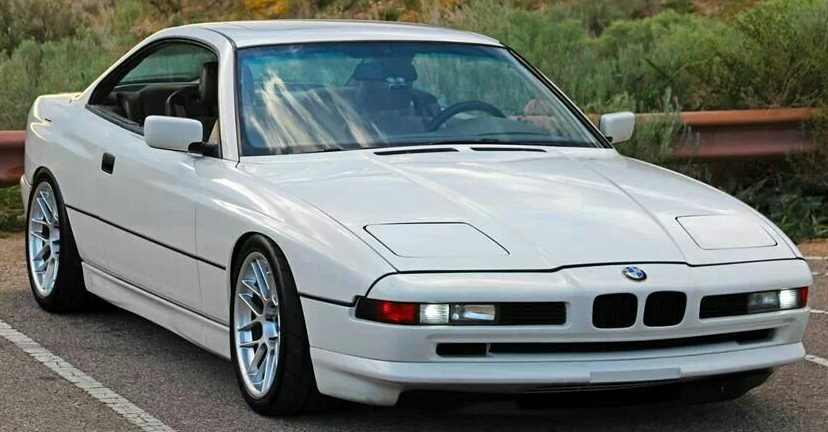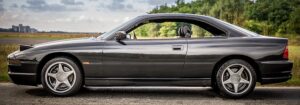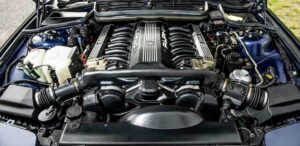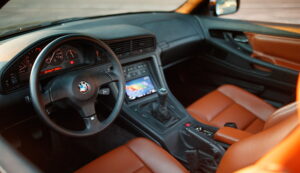Which BMW E31 to buy?
2. How much to spend for BMW E31?
3. Engine, bodywork and interior
4. Also worth knowing about BMW E31
What is BMW E31?
Which BMW E31 to buy? The BMW E31, commonly referred to as the BMW 8 Series, is a line of luxury grand tourer (GT) cars produced by the German automaker BMW from 1989 to 1999. The E31 8 Series was designed to combine high-performance capabilities with luxurious features, targeting the upper end of the automotive market. This coupe was characterized by its sleek and aerodynamic design, advanced technology, and powerful engine options.
The E31 was a significant departure from BMW’s previous models, boasting innovative features and a focus on both performance and comfort. The interior of the E31 was meticulously designed, incorporating high-quality materials, advanced electronics, and a driver-oriented cockpit.
Throughout its production run, the BMW E31 underwent various updates and revisions to enhance its performance, safety, and overall driving experience. It gained a reputation as a flagship model for BMW and remains a symbol of luxury and prestige in the brand’s history.
Here is a list of the main models of the BMW E31 (8 Series) along with their engine designations and years of production:
BMW 840Ci:
Years: 1993–1996
BMW 850Ci:
Years: 1990–1999
BMW 850CSi:
Years: 1992–1996
BMW 840i (European Model):
Years: 1993–1996
BMW 850i (European Model):
Years: 1989–1999
BMW 850Ci (European Model):
Years: 1992–1999
BMW 850CSi (European Model):
Years: 1992–1996
BMW 850CSi “50 Jahre Edition” (European Model):
Year: 1996
How much to spend for BMW E31?
The cost of a BMW E31 can vary widely based on factors such as the model year, condition, mileage, and any modifications or special features. As of my last update in September 2021, you could expect to find a decent BMW E31 starting around €8,500 for a project car or one in need of significant restoration. However, well-maintained and low-mileage examples or those with desirable features could command significantly higher prices, potentially ranging up to €42,000 or more.
Engine, bodywork and interior
-
Engine: The BMW E31 (8 Series) was offered with a range of powerful and technologically advanced engines during its production run. These engines included both V8 and V12 configurations. The engines were known for their smooth power delivery and impressive performance, contributing to the E31’s status as a high-performance grand tourer.
- V8 Engines: The V8 engines used in the E31 included variations of the M60 and M62 engine families. These engines offered a balance of power and efficiency, making them suitable for both spirited driving and long-distance cruising.
- V12 Engines: The V12 engines were at the top of the E31’s power lineup, delivering exceptional horsepower and torque. The most notable V12 engine used in the E31 was the S70, which powered the rare and high-performance 850CSi model.
- Bodywork: The bodywork of the BMW E31 featured a distinctive and elegant design. The car’s sleek and aerodynamic profile was emphasized by its long hood, short rear deck, and pop-up headlights (which were later replaced by fixed projector-style headlights). The body lines were well-defined and flowed smoothly, contributing to its visual appeal and aerodynamic efficiency.
- Interior: The interior of the E31 was characterized by luxury, comfort, and advanced technology. High-quality materials, including premium leather and wood trim, adorned the cabin. The dashboard was driver-focused, with a center console that housed various controls and the infotainment system. The E31 was equipped with several innovative features for its time, such as an onboard computer, advanced climate control, and power-adjustable seats.
- Technology: The E31 featured various technological advancements, including an Adaptive Damping System (ADS) that allowed drivers to adjust the suspension settings for different driving conditions. This contributed to a balance between sporty handling and comfortable cruising.
- Build Quality: The E31 was built with meticulous attention to detail and craftsmanship, reflecting BMW’s commitment to producing a premium grand tourer. This attention to quality extended to the fit and finish of both the exterior and interior components.
The combination of powerful engines, elegant bodywork, and luxurious interior made the BMW E31 a unique and sought-after vehicle among enthusiasts and collectors alike. Its blend of performance and sophistication contributed to its iconic status in the automotive world.
Also worth knowing about BMW E31
-
Innovative Features: The BMW E31 (8 Series) introduced several innovative features and technologies for its time. One notable example was the availability of an electronic drive-by-wire throttle system, which was a significant advancement in improving throttle response and engine control.
- Active Rear Axle Kinematics: The E31 was one of the first vehicles to feature an active rear axle kinematics system, known as the “Integral Rear Axle.” This system helped enhance stability and handling by automatically adjusting the toe angle of the rear wheels during cornering.
- Advanced On-Board Computer: The E31 was equipped with an advanced on-board computer that provided real-time information about various vehicle functions. It offered features such as trip data, fuel efficiency calculations, and maintenance reminders.
- Pop-Up Roll Bars: In terms of safety, the E31 included innovative pop-up roll bars behind the rear seats. These roll bars were designed to deploy automatically if the car detected an impending rollover, providing added protection to occupants.
- BMW 850CSi: The BMW 850CSi was the high-performance variant of the E31. It featured a more powerful engine, upgraded suspension, larger brakes, and other performance enhancements. The 850CSi was produced in limited numbers and is highly regarded by enthusiasts.
- Production Numbers: The production numbers for the E31 were relatively low compared to other BMW models, making it somewhat exclusive. This rarity contributes to its desirability among collectors and enthusiasts.
- Styling and Influence: The E31’s design was influenced by Klaus Kapitza and focused on creating a balance between sportiness and luxury. Its iconic “pillarless” side windows and distinctive body lines contributed to its timeless aesthetic.
- End of Production: The BMW E31 was eventually succeeded by the BMW 6 Series, which continued the brand’s tradition of combining performance and luxury in a stylish package.
- Collectibility: Due to its unique design, advanced features, and limited production numbers, the E31 has gained a cult following among automotive enthusiasts and collectors. Well-maintained examples with low mileage and special features tend to appreciate in value over time.
- Ownership Experience: Owning an E31 can provide a blend of performance driving and luxury comfort. However, potential buyers should be aware that maintaining and restoring these vehicles can be a labor of love, as finding replacement parts and specialized expertise might be more challenging compared to newer models.
As with any classic car, potential buyers and enthusiasts interested in the BMW E31 should conduct thorough research, join enthusiast forums, and seek advice from experts to fully appreciate and understand the unique characteristics and considerations associated with owning this iconic vehicle.
Are you already a proud owner of a BMW E31? If so, check out our selection of parts for this car at the following link:
https://octoclassic.com/product-category/bmw/e31
Photos sources: pinterest.com, wallpaperflare.com, drive-my.com, wallpaperbetter.com











